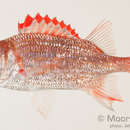Diagnostic Description
provided by Fishbase
Body reddish silver, iridescent bluish above; scales finely dotted with black; spinous dorsal silvery white, with broad red margin (Ref. 4201). Five oblique scale rows on cheek; body depth 2.7-3.15 in SL; head length (HL) 2.75-3.1 in SL; snout length 4.0-4.65 in HL; interorbital width 3.6-4.05 in HL; small mouth terminal to slightly inferior, maxilla reaching from below front of iris to below center of eye, upper jaw length 2.7-3.15 in HL; premaxillary groove reaching to about a vertical at the front edge of orbit; anterior end of nasal bone rounded; medial margin of nasal bone without spinule; small nasal fossa without spinules on its edge; upper edge of suborbital bone below the eye weakly serrated, spineless laterally; short preopercular spine 1/2-3/4 orbit diameter, 4.75-6.45 in HL; 3rd-5th dorsal spine longest 2.0-2.3 in HL; 3rd anal spine 1.2-1.55 in HL (Ref. 27370).
- Recorder
- Cristina V. Garilao
Morphology
provided by Fishbase
Dorsal spines (total): 11; Dorsal soft rays (total): 12 - 14; Analspines: 4; Analsoft rays: 8 - 9
- Recorder
- Cristina V. Garilao
Trophic Strategy
provided by Fishbase
Found in inshore waters. A nocturnal species (Ref. 75154).
Biology
provided by Fishbase
Inhabits surge-swept tunnels and crevices of the reef margin and reef front. Rarely occurs below 30 m, but has been observed at depths of 101 to 183 m in the Hawaiian Islands (Ref. 1602); majority of specimens collected in less than 3 m, often in tide pools (Ref. 27370). Benthopelagic (Ref. 58302). It disperses at night over sand flats and open reef bottom to feed on small crustaceans, crustacean larvae, and polychaete worms. Spine of preopercle venomous. Minimum depth reported taken from Ref. 30874.
Importance
provided by Fishbase
aquarium: commercial
分布
provided by The Fish Database of Taiwan
分布於印度-太平洋區,西起紅海與南非奧歌亞灣
,東至到夏威夷與復活島,北至日本南部與小笠原群島,
南至澳洲北部與奧斯垂群島。臺灣各地及離島的礁區皆可見。
利用
provided by The Fish Database of Taiwan
一般以一支釣及延繩釣的方法捕獲。魚肉白,但質地較爛,煮湯時肉易散開且多溶解油質,因此適合抹鹽油煎食用。唯須注意其內臟可能累積熱帶海魚毒。而它的鱗片及棘刺尖利,需小心刺傷。在水族館中也有人看上它鮮紅的體色,將它飼養做為觀賞魚。
描述
provided by The Fish Database of Taiwan
體呈橢圓形,中等側扁。頭部具黏液囊,外露骨骼多有脊紋。眼大。口端位,裂斜。下頜不突出於上頜。前上頜骨的凹槽大約達眼窩前緣的垂直線上;鼻骨的前緣圓形;鼻窩沒有小刺。前鰓蓋骨後下角具ㄧ強棘,長度約1/2眼徑;眶下骨上緣沒有側突的小棘。體被大型櫛鱗;側線完全,側線鱗數
42-45,側線至背鰭硬棘中間點之鱗片數 2.5;頰上具 5
列斜鱗。鰓耙數5-7+10-12=15-19。背鰭連續,單一,硬棘部及軟條部間具深凹,具硬棘
X-I,軟條12-
14(13);最後一根硬棘短於前一根硬棘。臀鰭有硬棘
IV,軟條 9;胸鰭軟條 15
;尾鰭深叉形。體淡銀紅色,上半部有藍色虹彩;鱗片有黑色細點;背鰭硬棘部透明銀白色,有寬的紅色外緣,紅色下方各有一個小白斑。以前所記載之乳斑棘鱗魚(/Sargocentron
lacteoguttatum/)為本種之同種異名。
棲地
provided by The Fish Database of Taiwan
主要棲息在珊瑚礁區,一般都逗留在礁緣湧浪區的洞穴與裂隙,或是礁石前面;小魚則常見於潮池區。不會成群住在一起,而是三三兩兩各自覓食,尋找隱藏在礁石附近的小型甲殼類、甲殼類幼生與多毛類的蠕蟲等食物。棲息深度在0-180公尺深的水域。性貪吃,垂釣時極為容易上鉤。
Sargocentron punctatissimum
provided by wikipedia EN
Sargocentron punctatissimum is a species of fish related to the squirrelfish.[1]
References

- license
- cc-by-sa-3.0
- copyright
- Wikipedia authors and editors
Sargocentron punctatissimum: Brief Summary
provided by wikipedia EN
Sargocentron punctatissimum is a species of fish related to the squirrelfish.
- license
- cc-by-sa-3.0
- copyright
- Wikipedia authors and editors
Description
provided by World Register of Marine Species
Inhabits surge-swept tunnels and crevices of the reef margin and reef front. Rarely occurs below 30 m, but has been observed at depths of 101 to 183 m in the Hawaiian Islands (Ref. 1602). It disperses at night over sand flats and open reef bottom to feed on small crustaceans, crustacean larvae, and polychaete worms. Spine of preopercle venomous.
Froese, R. & D. Pauly (Editors). (2023). FishBase. World Wide Web electronic publication. version (02/2023).
- license
- cc-by-4.0
- copyright
- WoRMS Editorial Board

